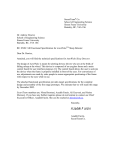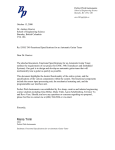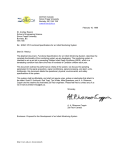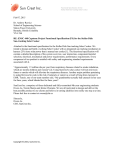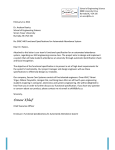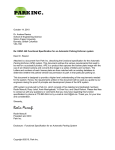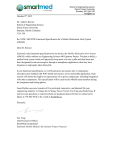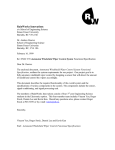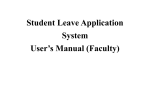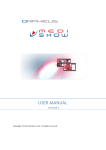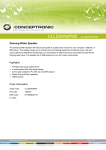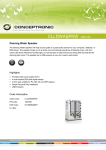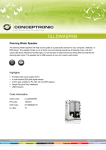Download M i N T - School of Engineering Science
Transcript
MiNT School of Engineering Science • Burnaby, BC • V5A1S6 http://www.sfu.ca/~echiua/mint • [email protected] the refreshing technologies June 25, 2001 Dr. Andrew Rawicz School of Engineering Science Simon Fraser University Burnaby, British Columbia V5A 1S6 Re: ENSC 340 Functional Specification: Dancing Orpheus Musical Suit Dear Dr. Rawicz, The attached document, Functional Specification: Dancing Orpheus Musical Suit, details the functional specifications of our project for ENSC 340. The purpose of this document is to detail the various system and interface requirements as well as the test methods that would be applied to our prototype to verify its functionality. Within the specification, some requirements are indicated as basic features that must be completed for the project deadline in August, whereas the enhancement features will be added only if time is available. MiNT consists of five innovative third year engineering students – Sharon Chang, Eddy Chiu, Tony Leung, Robert Sin, and Lydia Tse. If you have any questions or concerns about our proposal, please feel free to contact me by phone at (604) 4203628 or by email. Sincerely, Eddy Chiu MiNT, Inc. Enclosure: Functional Specification: Dancing Orpheus Musical Suit MiNT the refreshing technologies Functional Specification: Dancing Orpheus Musical Suit Project Team: Sharon Chang Eddy Chiu Tony Leung Robert Sin Lydia Tse Contact Personnel: Eddy Chiu [email protected] Submitted to: Dr. Andrew Rawicz – ENSC 340 Steve Whitmore – ENSC 305 School of Engineering Science Simon Fraser University MiNT the refreshing technologies Function Specification: Dancing Orpheus Musical Suit Executive Summary Advancements in technology have been an important factor in revolutionizing art and entertainment. With the introduction of the Dancing Musical Suit, which allows a dancer to play music at the same time, composing music will become easier and more fun than ever. The basic operations of the Dancing Orpheus Musical Suit include tracking a dancer’s motions and generating sequences of musical notes. In addition, the user can also vary these notes by changing the pitch or generating flats and sharps. The prototype is designed to output to a low power speaker or an amplifier. If this is available, various enhancement features such as sound effects and computer interface will be added. The development of this project spans a 13-week period, with August 24, 2001 being the scheduled completion date for a working prototype. i Copyright © 2001, MiNT MiNT the refreshing technologies Function Specification: Dancing Orpheus Musical Suit Table of Contents Executive Summary ......................................................................................................i Table of Contents .........................................................................................................ii Table of Figures............................................................................................................ii 1. Introduction..........................................................................................................1 1.1. Scope..............................................................................................................1 1.2. Reference Specification .................................................................................1 1.2.1. Applicable Documents...........................................................................1 1.2.2. Reference Documents ............................................................................1 1.3. Objectives ......................................................................................................1 2. System Requirements ..........................................................................................2 2.1. System Overview ...........................................................................................2 2.2. Physical and Environmental Requirements ...................................................3 2.3. System Requirements.....................................................................................4 2.3.1. General...................................................................................................4 2.3.2. Power Supply .........................................................................................5 2.3.3. Sound Quality and Effects .....................................................................5 2.3.4. Compatibility .........................................................................................5 2.4. Reliability and Serviceability.........................................................................6 2.5. Modes of Operation .......................................................................................6 2.6. System Limitations ........................................................................................6 3. Interface Requirements .......................................................................................7 3.4. Motion Detector User Interface .....................................................................7 3.5. Sound Generator User Interface.....................................................................7 3.6. Motion Detector Sound Generator Interface..................................................7 3.7. Sound Generator Speaker Connection Interface............................................8 3.8. Sound Generator Computer Interface ............................................................8 4. Testing Methods ...................................................................................................9 4.4. Motion Detector .............................................................................................9 4.5. Sound Generator ............................................................................................9 5. Regulatory Standards........................................................................................10 6. Documentation and User Training...................................................................11 7. Conclusion ..........................................................................................................12 Table of Figures Figure 1: System Overview ...........................................................................................2 Figure 2: Sensor placement............................................................................................3 ii Copyright © 2001, MiNT MiNT the refreshing technologies Function Specification: Dancing Orpheus Musical Suit 1. Introduction The Dancing Orpheus Musical Suit is a device that generates music based on a dancer’s motions. The device consists of eleven motion detectors and a sound generation unit. All musical notes at a wide range of pitches are featured by the Dancing Orpheus, allowing it to compose music at the same level of complexity as any other sophisticated musical instrument. The main objective for this project is to complete the assembly of a functioning device by August 2001. 1.1. Scope This document describes the basic functional requirements for the Dancing Orpheus Musical Suit as well as various enhancement features that would be implemented on the system prototype if time is available. 1.2. Reference Specification 1.2.1. Applicable Documents [1] Engineering Science Communications Handbook 7th Edition, S. Stevenson, S. Whitmore, 1999. [2] An Introduction to Low Power Radio, P. Bernie, J. Fairall, 1998. 1.2.2. Reference Documents [1] Proposal for the Dancing Orpheus Musical Suit, S. Chang, E. Chiu, T. Leung, R. Sin, L. Tse, 2001. 1.3. Objectives The following notations are used throughout this document: [R#] A functional requirement. (n) The priority of the requirement. (1) Basic functional requirement. (2) Enhancement feature. 1 Copyright © 2001, MiNT MiNT the refreshing technologies Function Specification: Dancing Orpheus Musical Suit 2. System Requirements 2.1. System Overview Figure 1 shows the system overview of the Dancing Orpheus Musical Suit. Dancer Speaker/ Amplifier Radio Transmission Sound Generator Motion Detectors Figure 1: System Overview The device tracks a dancer’s motions and sends the data to a detached sound generator through pairs of radio transmitter and receiver. The motion sensors are to be worn at the major body joints, each of which controls the playing of a predefined musical note. The placement of the sensors is shown in Figure 21. 1 Refer to [R8] and [R9] for further information on sensor placements. 2 Copyright © 2001, MiNT MiNT the refreshing technologies Function Specification: Dancing Orpheus Musical Suit front back Figure 2: Sensor placement When the sensors detect an angular movement beyond a preset threshold value, an activation signal will be generated, which causes the sound generator to produce the digitally synthesized tone. The Dancing Orpheus is designed mainly for user entertainment. However, with further developments it may become an instrument for physical therapy. Playing music with the Dancing Orpheus is a healthy exercise. Songs that involve varying degrees of movement and flexibility may be designed to test the patients’ recovery progress. 2.2. Physical and Environmental Requirements [R1] (1) Each motion detector would not interfere with the user’s motion. The prototype is expected to reside within a case with dimensions of (approximately) 5cm long, 5cm wide and 3cm high. Further development with more advanced equipment and circuit layout techniques would reduce the size by up to 50%. [R2] (1) The sound generator would be portable and would be able to reside within a case with dimensions of (approximately) 10cm long, 10 cm wide, and 5cm high. [R3] (1) The device would be able to operate at the range of temperature from 300c to 400c, around the body temperature. [R4] (1) The 11 motion detectors would not burden the user and would weigh less than 2kg altogether. 3 Copyright © 2001, MiNT MiNT the refreshing technologies Function Specification: Dancing Orpheus Musical Suit [R5] (1) The sound generator and a low power speaker together would weigh less than 5kg. [R6] (1) The case of the motion detector would reside within a water-proof case (made of a polymeric material) which protects the internal circuitry from sweat and other moistures. [R7] (1) The motion detector would be able to operate under vibration – from the dancer’s motion. 2.3. System Requirements 2.3.1. General [R8] (1) 11 motion detectors: i) 7 control the generation of the notes ii) 2 control the raising and lowering pitch iii) 2 control the generation of flats and sharps [R9] (1) Note generation detectors are distributed: i) 2 at the elbows ii) 2 at the knees iii) 2 at the shoulders iv) 1 at the back of the hip [R10] (1) Pitch controlling detectors are worn at the back of the left forearm. [R11] (1) Flat and sharp generation detectors to be worn at the back of the right forearm. [R12] (2) Effect generation detectors are distributed: i) 2 at the ankles ii) 2 at the wrists iii) 1 at the back of the neck [R13] (1) The transmission range from the motion detector to the sound generator would reach 50m. This is the range of transmission provided by common commercially available transmitters. [R14] (1) The sound generator outputs frequencies from 60Hz to 8000Hz (same frequency range as common computer speakers). [R15] (1) Each note turns off after playing for 2 seconds. 4 Copyright © 2001, MiNT MiNT the refreshing technologies Function Specification: Dancing Orpheus Musical Suit [R16] (2) The sound generator would mimic the sounds of various musical instruments. [R17] (2) The sound generator would incorporate various sound effects that are controlled by additional motion sensors. [R18] (2) The sound generator would record and play back a finite sequence of notes. [R19] (2) The sound generator would interface with a host computer for motion capturing. 2.3.2. Power Supply In order to achieve portability, Dancing Orpheus will be designed to operate under low power and run on batteries. [R20] (1) The motion detectors would operate on 2 button cell batteries that provide up to a total of 6V DC. [R21] (1) The sound generator would operate on a single 9V battery. [R22] (2) The device would have rechargeable power supplies. 2.3.3. Sound Quality and Effects [R23] (1) The sound generator would generate a bandwidth of 7 pitches of musical notes. [R24] (1) The sound generator would have sound quality similar to MIDI sound files. [R25] (2) The sound generator would incorporate sound effects such as adding echo, base and beats. 2.3.4. Compatibility The Dancing Orpheus will interact with existing audio products. If a computer interface is developed, it must conform to the corresponding data communication standards. 5 Copyright © 2001, MiNT MiNT the refreshing technologies Function Specification: Dancing Orpheus Musical Suit [R26] (1) The sound generator would be compatible with any common low power speaker. [R27] (1) The sound generator would be compatible with any common audio amplifier. [R28] (2) The sound generator would be able to interface with a host computer through an ISA connection. 2.4. Reliability and Serviceability [R29] (1) The Dancing Orpheus must operate for reasonably long periods of time – up to 24 hours – without failing. [R30] (1) The motion detectors should withstand continual vibrations from the user’s movements. [R31] (1) The motion sensors operate completely independently of one another. Therefore, the systems would continue to function if any single part fails. [R32] (2) New sound effects can be downloaded onto the sound generator with a host computer. 2.5. Modes of Operation [R33] (2) The sound generator would have a record mode. [R34] (2) The sound generator would have a playback mode. 2.6. System Limitations [R35] (1) If the user attempts to play more than one note, the one with the lower frequency will be generated. 6 Copyright © 2001, MiNT MiNT the refreshing technologies Function Specification: Dancing Orpheus Musical Suit 3. Interface Requirements 3.1. Motion Detector User Interface [R36] (1) Each note generation detector connects between two muscle groups attached to a joint. When the muscles move away from one another, a wire is pulled or released, which generates a corresponding analog voltage. [R37] (1) The pitch controlling detectors are positioned at the tips of the left index and middle fingers and are activated when they come in contact with the connector at the tip of the thumb. [R38] (1) The flat and sharp detectors are positioned at the tips of the right index and middle fingers and are activated when they come in contact with the connector at the tip of the thumb. [R39] (1) The elbows sensors are activated by linear flexion and turned off by linear extension. [R40] (1) The knee sensors are activated by linear flexion and turned off by linear extension. [R41] (1) The shoulder sensors are activated by raising the arm and turned off by returning the arm to the natural position. [R42] (1) The hip sensor is activated by twisting the waist (in any aesthetic way) and is turned off by returning to the natural position. 3.2. Sound Generator User Interface [R43] (2) If note and motion detector assignment becomes configurable, it would be controlled by a set of DIP switches. 3.3. Motion Detector Sound Generator Interface [R44] (1) The motion detectors will transmit wireless signals to receiver at frequencies ranging from 300MHz to 400 MHz. 7 Copyright © 2001, MiNT MiNT the refreshing technologies Function Specification: Dancing Orpheus Musical Suit 3.4. Sound Generator Speaker Connection Interface [R45] (1) Regular headphone jack. [R46] (2) A speaker output dedicated to sound effects. [R47] (2) Stereo sound quality. 3.5. Sound Generator Computer Interface [R48] (2) The sound generator would interface with a 32-pin ISA port. 8 Copyright © 2001, MiNT MiNT the refreshing technologies Function Specification: Dancing Orpheus Musical Suit 4. Testing Methods 4.1. Motion Detector [R49] (1) Activation and deactivation of each motion detector is verified using a logic analyzer. [R50] (1) All motion detectors are activated simultaneously to verify effects of signal interference. [R51] (1) Each motion detector would be tested on the angle extremity and force endurance. [R52] (1) Each motion detector would be tested on the sensibility and the force endurance. 4.2. Sound Generator [R53] (1) Each note will be played and verified using a logic analyzer. [R54] (1) All notes will be played simultaneously to verify the ability of the device to resolve the output. [R55] (1) Place the sound generator at 50m away from the dancer to verify data transmission at extreme distance. 9 Copyright © 2001, MiNT MiNT the refreshing technologies Function Specification: Dancing Orpheus Musical Suit 5. Regulatory Standards [R56] (1) Safety standards: i) ii) CSA C22.2 No 1010.1-92 IEC 1010-1:1990 +A1:1992 +A2:1995 iii) UL 3111-1 [R57] (1) Wireless communication standards: i) ii) iii) iv) v) [R58] (1) AR1B STD - T66 IC RSS 139 IC RSS 212 IEC-60950 UL-1950 Environmental standards: i) ii) iii) iv) v) HP Class C1 device. HP 757 – Temperature HP 758 – Humidity HP 759 – Vibration HP 760 – Shock 10 Copyright © 2001, MiNT MiNT the refreshing technologies Function Specification: Dancing Orpheus Musical Suit 6. Documentation and User Training [R59] (2) Documentation of the Dancing Orpheus consists of a five page user manual with instructions in English, French, German, Japanese, Spanish, Chinese, and Korean. [R60] (2) The user manual will be written for an audience with minimal experience with electronic device and music knowledge. [R61] (2) The user manual will include a set of sample dance moves for two songs. [R62] (2) The user manual includes a troubleshooting section. [R63] (1) Minimal user training should be necessary for use of the Dancing Orpheus. [R64] (1) Training of the device is completely provided by the user manual. [R65] (2) The company web site provides a collection of dance steps for most popular songs. 11 Copyright © 2001, MiNT MiNT the refreshing technologies Function Specification: Dancing Orpheus Musical Suit 7. Conclusion This document has outlined the details of the functional requirements of the Dancing Orpheus project. By August 2001, all basic requirements denoted by (1) will be fulfilled, whereas enhancement features denoted by (2) will be added if time is available. 12 Copyright © 2001, MiNT

















